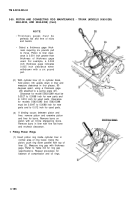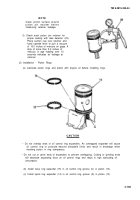TM-9-2815-205-34 - Page 313 of 596
TM 9-2815-205-34
(b)
(d)
(e)
Examine piston for score marks,
cracks, damaged ring grooves, loss of
tin plating, or indications of
overheating. Using a crocus cloth,
remove light score marks from piston.
Replace any piston severely scored or
overheated. Discard piston if cracks
are found across internal struts.
(2) Piston Pin
CAUTION
Do not polish or refinish piston
pin. Hand polishing or refinish-
ing will destroy precision finish
and result in rapid bushing
wear.
(a)
(b)
Inspect piston pin for signs of fretting.
Discard piston pin if fretting is present.
Measure piston pin diameter.
Diameter of new piston pin is 1.3746
to 1.3750 inches.
(3) Connecting Rod
(a) Check connecting rod for visual damage. Discard if rod is bent, had previous bearing
failure, was overheated (blued) at top or bottom end, or is fretted at split line between rod
and cap.
(b) Check for cracks using the magnetic particle inspection method (reference MlL-C-1949).
NOT E
Overheated bushings may become loose and creep together, thus blocking off supply
of lubricating oil to piston pin and spray nozzle.
(c) Check connecting rod bushings for indications of scoring, overheating, or other damage.
Compressed air used for cleaning purposes will not exceed 30 PSI. Use only
with effective chip guarding and personal protective equipment (goggles/shield,
gloves, etc.)
Check spray nozzle at upper end of connecting rod for plugged holes. Blow compressed air
through drilled oil passage in rod to ensure spray nozzle holes are open.
Inspect connecting rod bearing bores for burrs or foreign particles, Clean up minor burrs
with crocus cloth using circular motion.
3-183
WARNING
Back to Top




















